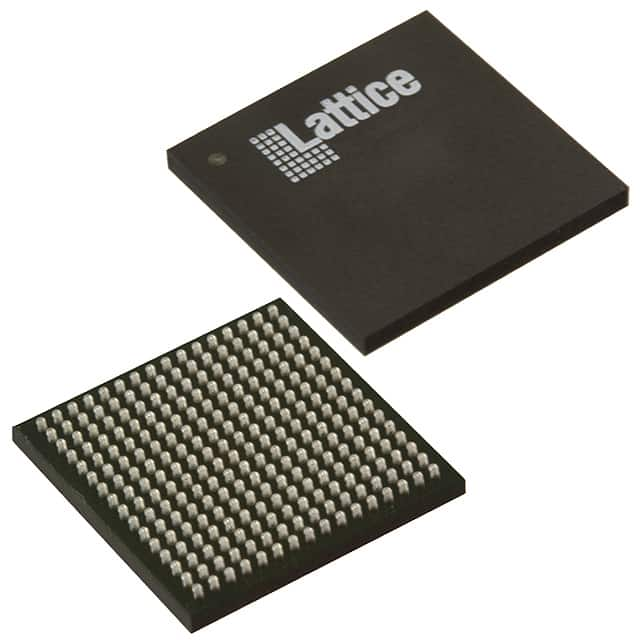LFE5U-25F-6BG256C
Product Overview
Category
The LFE5U-25F-6BG256C belongs to the category of Field Programmable Gate Arrays (FPGAs).
Use
This FPGA is commonly used in various electronic applications that require high-performance digital logic circuits. It provides a flexible and customizable solution for implementing complex digital designs.
Characteristics
- High-performance FPGA with advanced features
- Programmable logic cells for custom circuit implementation
- Embedded memory blocks for data storage
- Flexible I/O interfaces for connecting to external devices
- Low power consumption for energy-efficient operation
Package
The LFE5U-25F-6BG256C comes in a compact Ball Grid Array (BGA) package, which ensures reliable electrical connections and efficient heat dissipation.
Essence
The essence of the LFE5U-25F-6BG256C lies in its ability to provide a reconfigurable hardware platform that allows users to implement their own digital designs without the need for dedicated integrated circuits.
Packaging/Quantity
This FPGA is typically sold individually and is packaged in anti-static trays or tubes to prevent damage during transportation and handling.
Specifications
- Model: LFE5U-25F-6BG256C
- Logic Elements: 25,000
- Block RAM: 1,080 Kbits
- DSP Blocks: 80
- Maximum User I/Os: 208
- Operating Voltage: 1.2V
- Package Type: BGA
- Package Pins: 256
- Temperature Range: -40°C to 100°C
Detailed Pin Configuration
The LFE5U-25F-6BG256C has a total of 256 pins, each serving a specific purpose in the overall functionality of the FPGA. The pin configuration includes input/output pins, power supply pins, clock pins, and configuration pins. A detailed pinout diagram can be found in the product datasheet.
Functional Features
- High-speed performance: The LFE5U-25F-6BG256C offers fast data processing capabilities, making it suitable for applications that require real-time operations.
- Reconfigurability: This FPGA allows users to modify the circuit design even after deployment, enabling flexibility and adaptability in various scenarios.
- Embedded memory: The built-in memory blocks provide efficient storage for intermediate data, reducing the need for external memory components.
- Flexible I/O interfaces: The FPGA supports a wide range of communication protocols, allowing seamless integration with other devices.
- Low power consumption: The LFE5U-25F-6BG256C is designed to minimize power usage, making it suitable for battery-powered applications.
Advantages and Disadvantages
Advantages
- Customizability: Users can implement their own digital designs, tailored to specific application requirements.
- Cost-effective: FPGAs eliminate the need for dedicated integrated circuits, reducing overall system costs.
- Time-to-market: The reprogrammable nature of FPGAs enables faster prototyping and development cycles.
- Versatility: FPGAs can be used in a wide range of applications, from telecommunications to industrial automation.
Disadvantages
- Complexity: Designing and programming FPGAs requires specialized knowledge and expertise.
- Limited resources: FPGAs have finite logic elements and memory blocks, which may restrict the complexity of designs.
- Power consumption: While efforts are made to reduce power usage, FPGAs generally consume more power compared to dedicated ASICs.
Working Principles
The LFE5U-25F-6BG256C operates based on the principles of configurable logic. It consists of an array of programmable logic cells interconnected through configurable routing resources. These logic cells can be programmed to implement various digital functions, allowing users to create custom circuits. The configuration of the FPGA is stored in non-volatile memory and loaded during startup.
Detailed Application Field Plans
The LFE5U-25F-6BG256C finds applications in a wide range of fields, including:
- Telecommunications: Used for signal processing, protocol conversion, and network optimization.
- Industrial Automation: Enables control systems, motor drives, and sensor interfacing.
- Aerospace and Defense: Utilized in radar systems, avionics, and secure communication equipment.
- Medical Devices: Supports medical imaging, patient monitoring, and diagnostic equipment.
- Automotive: Used for advanced driver assistance systems (ADAS), infotainment, and engine control.
Detailed and Complete Alternative Models
- LFE5U-45F-8BG256C: A higher-end model with 45,000 logic elements and increased memory capacity.
- LFE5U-85F-9BG256C: Offers even greater performance with 85,000 logic elements and enhanced I/O capabilities.
- LFE
技術ソリューションにおける LFE5U-25F-6BG256C の適用に関連する 10 件の一般的な質問と回答をリストします。
Sure! Here are 10 common questions and answers related to the application of LFE5U-25F-6BG256C in technical solutions:
Q: What is the LFE5U-25F-6BG256C? A: The LFE5U-25F-6BG256C is a field-programmable gate array (FPGA) manufactured by Lattice Semiconductor.
Q: What are the key features of the LFE5U-25F-6BG256C? A: The key features include 25,000 LUTs, 6 input/output banks, 256-ball grid array package, and support for various I/O standards.
Q: What are some typical applications of the LFE5U-25F-6BG256C? A: The LFE5U-25F-6BG256C is commonly used in applications such as industrial automation, telecommunications, automotive electronics, and medical devices.
Q: How can I program the LFE5U-25F-6BG256C? A: The LFE5U-25F-6BG256C can be programmed using Lattice Diamond design software or other compatible programming tools.
Q: What are the power requirements for the LFE5U-25F-6BG256C? A: The LFE5U-25F-6BG256C typically operates at a voltage range of 1.14V to 1.26V, with a maximum power consumption of 1.5W.
Q: Can I interface the LFE5U-25F-6BG256C with other components or microcontrollers? A: Yes, the LFE5U-25F-6BG256C supports various communication interfaces such as SPI, I2C, UART, and GPIOs, allowing easy integration with other components or microcontrollers.
Q: Does the LFE5U-25F-6BG256C support high-speed data processing? A: Yes, the LFE5U-25F-6BG256C is capable of high-speed data processing with its built-in high-performance DSP blocks and dedicated memory resources.
Q: Can I use the LFE5U-25F-6BG256C for real-time signal processing applications? A: Absolutely! The LFE5U-25F-6BG256C's low-latency architecture and high-speed capabilities make it suitable for real-time signal processing tasks.
Q: Are there any development boards available for the LFE5U-25F-6BG256C? A: Yes, Lattice Semiconductor offers development boards specifically designed for the LFE5U-25F-6BG256C, providing a convenient platform for prototyping and testing.
Q: Where can I find additional technical documentation and support for the LFE5U-25F-6BG256C? A: You can find detailed technical documentation, application notes, and support resources on the official Lattice Semiconductor website or by contacting their customer support team.
Please note that the answers provided here are general and may vary depending on specific requirements and use cases.


